Arepas are very easy to prepare. First, you will need a few basic things.
– Mixing Bowl
– Measuring Spoons
– Measuring Cup
– 1 cup Harina PAN (Discussed here).
– 1 cup lukewarm water
– ½ teaspoon salt
Next, you will prepare the dough.
Add the Harina PAN and the salt into the mixing bowl and mix together using your hands. Then, little by little add the water and knead and mix the dough using your hands. You must knead the dough until the mix is soft, firm and has a uniform consistency without any grains.
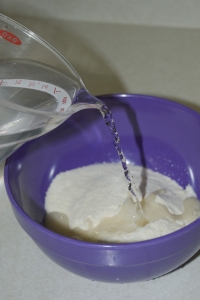
Add Water, Salt and Harina PAN
Another way if doing it is to first add the water and the salt into the mixing bowl and stir that together, and then proceed to add the Harina PAN little by little.
It is up to you to decide which method to use. I usually had preferred to mix the water and the salt first, so to make the water salty and spread the saltiness evenly through the dough. However, I found that using all the water first usually resulted in having to add more Harina PAN to the mix latter in order to get the right consistency.
Therefore I think the best way to go about it is to add the salt to the water in the measuring cup, and have the Harina PAN in the mixing bowl. That way you add as much water as needed, but you also distribute the salt evenly and then proceed to knead.
Once the dough is ready you let it sit for 5 minutes.
Now you are ready to form the arepas. You should grab a handful of the dough, and with both hands make a nice sized ball of about 2” to 2.5” in diameter. Then you use one hand to hold the ball and the other to flatten it ever so slightly with your fingers, turning it around so you flatten it evenly. The thickness is really up to you and up to the type of arepa you are going to prepare. I usually flatten it to about 0.5” or 0.75” thick. And if you are using a “Tostiarepa” you don’t event have to worry about flatting it, because it will do it for you. Now that you have the basics, you can decide to cook your arepa in several different ways.
Arepas Asadas
This is probably the most common way to cook an arepa. I believe the translation would be something like roasted or grilled Arepas. The best way to do this is with what we call a “BUDARE”, which is basically a cast iron round griddle (think Lodge Logic). You would first seal them at a higher temperature and then cook the inside at a medium temperature flipping them over constantly.
Arepas Fritas
These are probably the most delicious ones, because they are Fried arepas, and lets face it, anything fried tastes 10 times better. You would simply heat up about 2 cups of oil at medium heat in a pan, or better yet, in a fryer or Dutch oven. After the oil is hot enough you would fry the arepas for about 10 minutes or until they are golden on both sides.
If you wish to fry your arepas, I recommend that you flatten them further, to about 0.25” thick, and also its tradition to open a hole with your finger in the middle of the fried arepas (don’t ask me why).
Usually, in Venezuelan restaurants, instead of serving bread and butter while you wait for your food to arrive, we serve “arepitas con nata”. These are small little about 1.5” in diameter (cooked) fried arepas served directly from the fryer with either butter or delicious “nata”, which is hard to explain, because I really never though of it. It is sort of like a sour cream, but its cheesier and buttery, like cream cheesy but with a more liquid consistency.
Arepas Horneadas
These are baked arepas. They usually have to be “sealed” using the Arepas Asadas technique on a cast iron round griddle for about 5 minutes on each side on high heat. Then, they are baked in the oven at about 180º C until they start to puff a bit and the crust starts to come up a bit from the inside dough, which is usually about 20 to 30 minutes.
TostiArepa
The arepa toaster will basically toast the arepas in about 7 minutes. All you have to do is place a large enough ball of dough on each of the compartments in the toaster and press the cover down. You should open it back up and check that you had enough dough, or that you didn’t have too much dough. If you had too much just remove the excess pressed out with your fingers. If you had too little add more dough and reshape the ball. You can also add a bit of butter to each compartment before you put the dough in. I think the toaster is non-stick, but then the crust will taste like butter.
Now you are ready to enjoy your arepa with any filling you want. I will cover fillings in the next post, but for now you can enjoy them with butter, your favorite type of cheese and any kind of sandwich meat.
Tips
Arepas become hardened in only a few hours, so you should cook them when you want to eat them. Also, if they are already hardened, you can damp a paper towel or two in water, and cover the arepa and then stick it in the microwave for about 30 seconds or so. You can however prepare the dough and refrigerate it beforehand and then proceed to cook them when you are ready to eat them. You can also refrigerate leftover dough for about 5 days, just make sure you cover it with a damp cloth and spray with water or even a little bit of oil. You can also prepare baked arepas by sealing them using the griddle first, then freezing them, and simply baking them for 20 to 30 minutes when you are ready to eat them.
Some people add different things to their dough before they cook the arepa to add flavor to the dough. I have heard and seen a lot of different additions including milk, oil, butter, cheese, eggs, and even honey. They all have a different taste, but I have to say I have NEVER tried an Arepa I didn’t like and I have NEVER met anyone who didn’t like Arepas 🙂
Check out Arepas on Chef John’s Blog and Also on Bobby Flay Throwdown
¡Buen Provecho!
NEW!!! – Download the One-Page Recipe Printout [Recipe: Venezuelan Arepas PDF Printout]

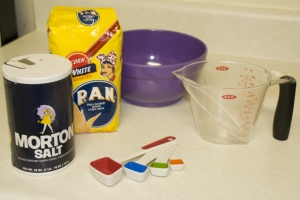
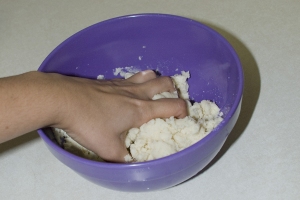
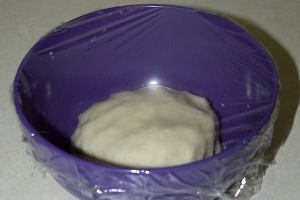
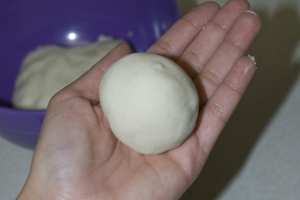
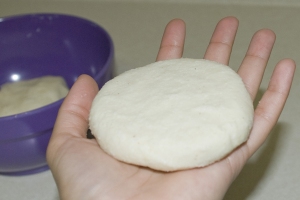
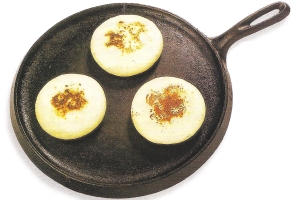
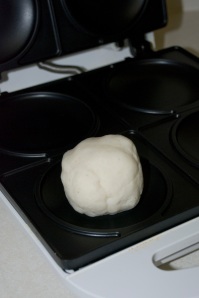
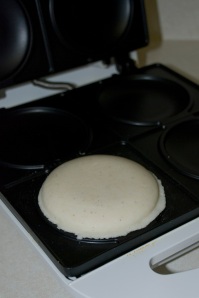
Is it okay to place a portion of this in my personal web site if I post a reference to this site?
Yes, of course. As long as you have link to my site, you can post a quote from my articles 🙂
Me encanta tu página. Muchas gracias por compartir las recetas, me es de utilidad para explicar a los cocineros en el extranejro. Por cierto, mi suegra en algunas ocasiones agrega cebolla rallada a la masa y hace arepas fritas. Tal vez las has probado. Deliciosas!
Mile,
Me alegra que te guste el blog. Mi mamá también hacia Arepas Fritas, con el hueco en el centro. Pero nunca las he probado con cebolla… Suena rico. Saludos.
MW
love this site!! I was born in Venezuela, and immigrated at a young age, so I did not know how to make some of my childhood favorite dishes. I am glad I stumbled into here 🙂
Cynthia,
Thank you very much for your comment. I am always happy to know that other Venezuelans who live outside of Venezuela are reading my blog and learning how to make food that reminds them of their country and brings back those childhood memories. Also, thank you for following the blog as well 🙂
MW
Muchas gracias por tu trabajo y por compartir todas estas recetas tan sabrosas. Quiero compartir contigo un tip con respecto a las arepas, cuando mi mama las hace les anade una cucharada de leche en polvo para evitar que se pongandan duras y tambien ayuda a que se doren muy bonitas. Gracias
Querida Belkys,
Gracias por visitar el blog, y por tus comentarios. Tu tip también esta muy bueno. Lo haré la próxima vez que cocine arepas. Precisamente estoy en busca de las mejores maneras de mantener las arepas, por ejemplo para comerlas al día siguiente.
MW
I am Colombian, but have recently started dating a Venezuelan. We argued over which country makes the best arepas, until he took me to a Venezuelan arepa joint in Doral. I must concede, you all do it much better! I made it my mission to try to make them at home, so thank you so much for the recipe and the tips.
Just another question, though. Can you griddle the arepas, then fry them to finish them off?
Kaypeabrokebaker,
Thank you so much for visiting the blog, and thank you for your comment. I am glad you and your significant other can agree that Venezuelan Arepas are better. I am also happy you found my blog and you can now make Venezuelan Arepas with my recipe.
It is funny that you ask this question about sealing the arepas on the griddle and then frying them. This is definitely not something I recommend or approve of. And very recently someone in my family did this in front of me. I think the arepa came out weird. I would suggest you cook them one way or another, but not both. You can definitely fry them, but you can fry them as soon as you are done molding them into their disk shape, you do not have to seal them on the griddle and then fry them. It is an extra step that you really should skip.
Please let me know how your arepas turned out and post a photo if you can.
MW
MW,
Thank you for the reply. I really wasn’t sure about the griddle/fry technique. When I had the stuffed arepa in Doral, it kind of looked fried, but it had griddle marks on it. I might fry half and griddle half and see which ones I prefer.
I will definitely let you know how they turn out. And, if the universe aligns itself in my favor, perhaps I can also share my arepa-making adventure on my blog. I will, of course, give credit where credit is due and link back to your site.
Thanks again!
Kay Pea
Kay Pea,
You know… now that I think about it, and based on what you said about the Arepas in Doral looking fried and also having griddle marks, I think I know what happened. Some people place the arepas on the cast iron griddle without using oil or anything, because they have a good griddle that won’t stick, and you really don’t need to add anything. However, I have seen people spray their griddles a bit with either spray-oil, or even a thin coat of butter or oil, and this is what may give those Arepas you ate in Doral that fried look, but also griddle marks.
Thank you for engaging in an interesting conversation through this blog. Please report back to us, and share a link if you do feature your arepa making adventure in your own blog.
Saludos,
Melissa
Thank you for all of your valuable information. On a whim, I ended up trying to make arepas today, with mixed results. I tried fried, griddled, and stovetop using a parilla (which is the way my mother always did them). The griddled ones did not turn out very well, and I ended up frying them after griddling to try to salvage them (yes, I know you specifically said not to do that…sorry!!). The fried ones and the parilla ones came out pretty good, but my dough cracked a lot when I was trying to form the disks. I think I need to add more water next time. I ended up slicing them open and filling them with lechon asado. Unfortunately, since this was an impromptu experiment, I neglected to take pictures. Oops.
Just out of curiosity, how are the arepas supposed to be in the middle> When I cut mine in half, some of the masa stuck to the knife. Is that normal, or was it undercooked?
Kay Pea
Kay Pea,
Thank YOU for engaging in a very interesting debate. LOL. I wonder what it is that you call griddle and parrilla and what is the difference? Do you mean the griddle is the ‘budare’ like a cast iron flat pan, and then parrilla was on a rack on top of a live fire? Sorry, I’m just confused and don’t want to get lost in translation here.
Yes, if your dough starts cracking, just add a bit more water. You don’t have to add it to the entire mix and mix it again, you can just keep a bowl with water and wet your hands a bit as you are shaping them so they don’t crack.
Lechon Asado filling sounds amazing. I really wish I could have seen a picture of your arepas, but I completely understand why you didn’t take them 😉
The masa inside the arepas will always stick to your knife just a little. If it sticks so much that when you are cutting them open you take a big chunk from the inside because they stuck to the knife then it is definitely undercooked. But it will always stick a little.
Again, thank you for reporting all your findings back to us. What did your Venezuelan boyfriend think of them? Which one did he like?
Saludos,
Melissa
The “parrilla” is like a wire rack that gets placed on the stovetop. It looks like this one here: http://www.tucocina.net/product_detail.php?id=33
We place the rack over one of the stove burners on med-high and place the arepas there to cook. As far as griddles go, something like this is what I used (because it’s what I had): http://www.amazon.com/07061-22-inch-Electric-Griddle-Removable/dp/B005FYF3OY/ref=sr_1_1?ie=UTF8&qid=1390860461&sr=8-1&keywords=electric+griddle
I would have never thought about keeping a bowl of water handy! I will do that next time while I shape the arepas. The masa inside the arepas didn’t stick in chunks, so I guess they were cooked fine. Good to know that I am on the right track!
I’m almost ashamed to report now that my boyfriend didn’t actually get to have any. I had some friends come by to be my guinea pigs, and they liked both fried and “a la parrilla” the same. I figured it was too risky to let an expert taste them without doing a trial run first! I’m sure he’ll forgive me, LOL.
Next time, there will be pictures. I promise! Thanks again for all of the helpful advice!
Hey! I know it’s been a while, but I FINALLY got around to posting my arepas on my blog. I linked your blog on the post. Thanks again for all of your help!
Kaypeabroker,
Thank you for linking back to my blog.
MW
Saludos desde Puerto Rico, compré la maquina por internet pq aqui no se consigue. Mañana estaré preparandole arepas a mi esposo por primera vez. El tiene grandes expectativas ya que mi suegra y toda su familia es Venezolana. Estoy loca por q llegue Agosto, la temporada de aguacates para hacer la reina pepiada, mi favorita!
Monica,
Gracias por visitar el blog y por tu comentario. Me alegra saber que pudiste comprar un Tostiarepa y que te llegue a Puerto Rico. Avisanos que tal te quedaron tus primeras arepas y si puedes envíanos unas fotos de ellas.
MW
Found your blog today! What a cool ingredient, Harina Pan, I just ordered it from amazon.com, as I’ve always been curious about arepas made the authentic way
You’ve built a great site for Venezuelan recipes, I will be following you!
Sally,
Thank you for visiting the blog and thank you for your comment. Please report back after you’ve made arepas (with a photo if possible) and let us know what you think. I hope you like them as much as I do.
MW
Hello!! I made arepas in my cast iron and now I can’t get it clean!! Do you have any tips??
Hi Cassie,
Thank you for visiting the blog and thank you for your comment/question. I apologize for the late reply. I think its best for you to follow directions on the cast iron brand itself of the one you have. There are a lot of different ones out there and some have specific instructions on how to and how not to do so. I wouldn’t want to give you a bad recommendation that might ruin your cast iron, especially if it was an expensive one.
My mom used to do is with a simple sponge, soap and hot water, but I would definitely suggest to go with whatever your cast iron brand recommends.
-MW
Hello, I found this recipe today when preparing for a dinner invite and I think it’s the most comprehensive on arepas and Venezuelan food that I’ve seen so far. Love it!
I have a question in terms of preparation. I want to do arepas as a main (probably with two filling options, pulled pork and refried beans). I want them to be as fresh as possible and therefore am considering the best preparation option. I think I will do the sealing and then baking method. IN your opinion, should I:
A) prepare the dough, and then seal and bake when the guests are already there
B) prepare the dough and seal in the pan before the guests arrive, and only bake them directly before eating? Do you think B would work? That would of course be easier….
Kind regards
Karin
Hi Karin R,
Thank you for visiting the blog and thank you for your comment. I am glad you found it useful. I think if you are already going to have your fillings of pork and beans pre-made beforehand, then you should make your arepas beforehand as well. That way you’re not stuck in the kitchen while your guests are already there. It it is perfectly fine to have arepas sealed and then bake them when your guests arrive. I definitely think option B would work.
I was just in Florida visiting my family and they have frozen arepas in the freezer that they make and seal beforehand. I was glad to be able to just grab one, put it in the oven, bake it and eat it. It was delicious!!! A trick one of my aunts does when she has them in the freezer is wet the arepa a bit with some water before putting it in the oven. She says is to prevent them from being too dry from going from the freezer into the oven. My mom also makes arepas and saves the leftover dough, and the next morning she just makes another one real quick. That’s the beauty and simplicity of arepas.
I hope this was helpful
-MW